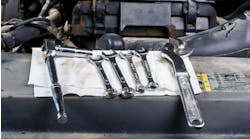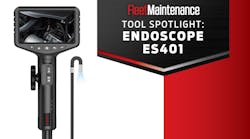Tire inflation has long been a topic of conversation when it comes to commercial vehicle tires.
Proactive fleets have tire inflation well under control, and that helps maximize tire life and keeps tire costs in check. Since quality tires that are properly maintained affect driver satisfaction, tire life, and fuel economy, inflation maintenance is an opportunity to reduce costs and improve driver retention.
Here’s what fleets can do to ensure a high-quality inflation program.
1. Use calibrated gauges
It is important to ensure tire gauges in the shop and on the vehicle are accurate. Gauges get dropped, and even if they don’t look like it, they’re sensitive pieces of equipment. If a fleet is not testing each gauge and recalibrating them monthly against a master, there is a good chance they are inflating tires to the wrong level.
It is a good idea to have a psi test station set up along with a master gauge in a highly visible area of the shop. Some fleets have drivers swap out their gauges for a calibrated gauge once a month. It is difficult to have a good tire program if the gauges can’t be trusted.
2. Start with the chart
Cooper Tire, like most major tire manufacturers, provides load-inflation tables based upon Tire and Rim Association guidelines. With a typical 6x4 legal load, there will be 34,000 lbs being carried by eight drive tires, or 4,250 lbs per tire. The table shows the drive tires can support that load at as little as 75 psi fully loaded. Yet, many fleets run a standard inflation pressure at 100 psi because, they say, “That’s what we’ve always done. It’s easy for our drivers to remember, and it gives us more margin for error if a tire leaks.”
While overinflation may be inefficient and costly, significant underinflation can be catastrophic. A blowout could occur. So what’s the optimal pressure? Like so many things in life, the answer is: it depends.
Every tire and fleet has a “personality.” The most cost-effective tire programs come from matching the right tire to the right application at the right inflation pressure. It takes a little time and some discipline, but the effort will pay off.
The bottom line is fleets need to think differently about air pressure. The reality is the tire doesn’t actually support the load, the air does. Inflation pressure primarily manages two things: the shape of the tire footprint and the amount of sidewall deflection.
Overinflation can pose several problems. The biggest is premature and irregular wear since the tire won’t have an optimal footprint patch to the road. It will ride more on the crown of the tire so part of the tread is scrubbing its way into and then out of the contact patch causing rapid and uneven wear. Traction will also be compromised, and that really comes into play in winter. There may also be an increase in the occurrence of impact breaks since the tire sidewalls have less flex. Finally, overinflation impacts fuel economy.
Fleets need to break this cycle and keep tires at their proper inflation level. Only then can they see the true performance engineered into the tire, and that will provide savings in the form of lower cost of ownership.
The impact of not following the chart is big. While operations vary significantly, running tires that are just 10 percent underinflated may require them to be removed from service 10 percent early. At 20 percent underinflated, tread life may be reduced by as much as 25 percent.
3. Audit inflation levels
Yard checks may seem inconvenient but are necessary. It is important to benchmark tire inflation and identify problem areas. Only then can a fleet take steps to improve their tire program.
For example, what percent of a fleet’s duals – both on the tractor and trailer – have inflation pressures within 5 psi of each other? Just a 5 psi difference in inflation between duals is the equivalent of one tire having a circumference that is 5/16” smaller. That means during every rotation cycle, the smaller circumference tire must scuff ahead to keep up with the tire with more inflation. These tires rotate around 500 times per mile, so simple math means 500 multiplied by 5/16” translates to 156.3” per mile, or about 13’ per mile. Imagine dragging a tire 13 feet every mile, under load. The impact is significant.
4. Tire-related concerns beyond air pressure
Another area of tire service to watch is retreads. Similar to inflation, circumference is key. In some cases, fleets will get identical retreads back from their retreader, but the casings may be different. Each brand and model may have a slightly different diameter, so while two tires may look identical when they come back from the retreader, one may be significantly taller than the other. This is why it is recommended that fleets use a circumference band, measuring tape, or have a height gauge mounted in the shop to check circumference. Otherwise, a fleet could be putting mismatched duals together which will cause one tire to wear prematurely.
5. Incentivize drivers
With today’s advanced trucks, it’s possible to gauge how well a driver handles the truck; hard braking, quick starts, and fuel economy can all be tracked, making trends evident. Some fleets offer bonuses for tire wear and proper tire inflation. If the driver keeps tire inflation at the proper level and does fingertip diagnostics on each tire during pre-trip inspections, tires will have longer lives. How drivers take care of tires can be easily tracked when the truck returns to the terminal for maintenance.
If these tips are followed, fleets stand a solid chance of pulling the drive tires at 2/32nds and the steers at 4/32nds, and casings should be in great shape for retreading. A fleet can extend its budget on tires by maximizing mileage and retreads. Proper tire selection is one key to doing that, but it’s the maintenance practices – especially proper tire inflation – that keeps trucks and trailers operating as efficiently and safely as possible.
Jason C. Miller is Cooper Tire’s national fleet channel sales manager. He has spent years working in all aspects of the tire industry, mastering complex tire programs for some of the largest fleets in North America. A member of the Technology and Maintenance Council (TMC) of the American Trucking Association, Jason is also a TIA certified tire instructor and former ASE certified technician. He has a bachelor’s degree in information technology and a master of science degree in integrated marketing communication from Northwestern University. Jason is the author of the book, “Selling by the Numbers,” and has written numerous tire-related articles for industry publications.



